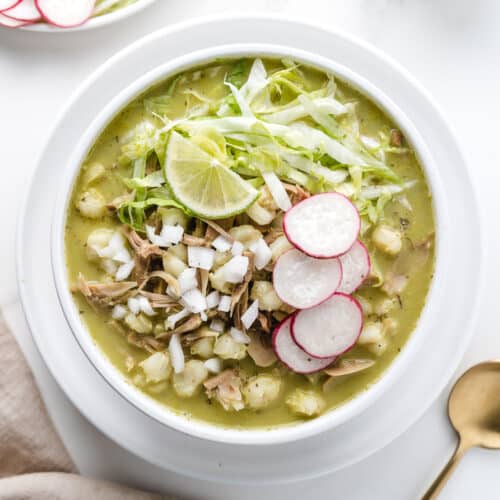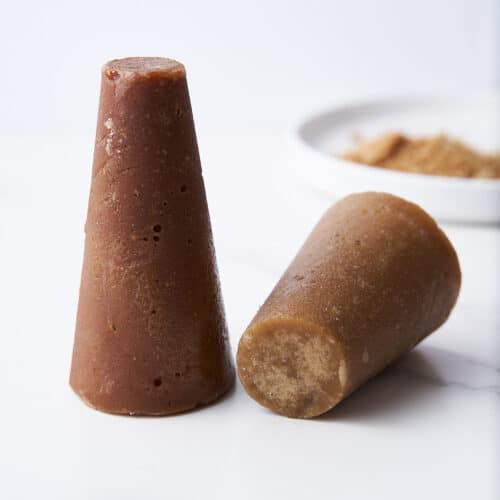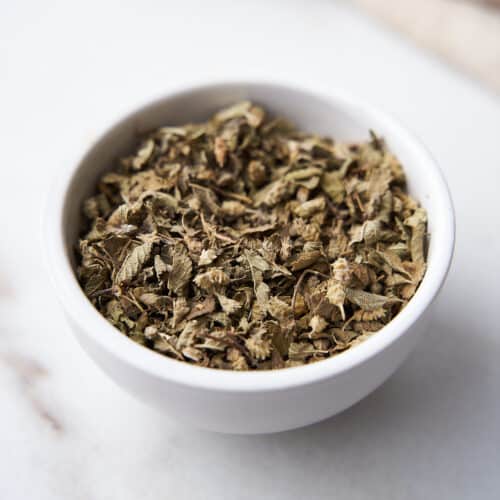What is Hominy?
Hominy is a staple ingredient in Mexican, Southern American, and Latin American cuisines, from recipes like freshly made corn tortillas and tamales to grits and canjica. Find out exactly what it is, how to prepare it, some delicious recipe ideas, and everything in between!

What is hominy?
Hominy is a traditional ingredient that’s been used extensively for centuries in Mexican and other Latin American cuisines. Once field corn undergoes a particular type of processing, called nixtamalization, it is then known as hominy.
Corn kernels are added to an alkaline solution, such as lye or lime, where they’re steeped and boiled. This step helps to remove the husks of the kernels and soften them, making them easier to digest.
In the southern United States, grits and Three Sisters vegetable medley are popular ways to utilize hominy. Even further south into Brazil, you can find hominy-based sweets like canjica. In Colombia, there is another type of soup, called mute.
For more information on the nixtamalization process, check out my masa harina post.
Varieties of hominy
The most common varieties of corn used to make hominy are dent, flour, or flint. You’ll see it sold in cans or dried in bags (similar to how beans are sold). It comes in three main colors:
- Blanco: White hominy is the mildest in flavor and most tender in texture.
- Amarillo: Yellow hominy is slightly sweeter and firmer than white hominy.
- Azul: Blue hominy is the chewiest and most intense in flavor.
The most common type used in soups is white hominy, but the other colors are often used to make products like grits and yellow or blue corn tortillas.
Flavor profile
In general, hominy has a slightly earthy and mild flavor that is different from your typical sweet corn. In addition to increasing its digestibility, the nixtamalization process also gives it a nutty taste.
It’s tender and chewy, making it a popular ingredient in many dishes. Its fluffy texture is like a sponge that absorbs flavors and liquids in recipes like soups, stews, and chilis.

Hominy vs. cornmeal
Cornmeal and hominy are both products derived from corn, but they have distinct differences in processing and use. While cornmeal is made from ground dried corn kernels, hominy can only be made from nixtamalized corn.
Cornmeal can be fine or coarse in texture, and yellow or white depending on the corn type. Hominy can also be coarse (for hominy grits) or fine (for masa harina).
Cornmeal is popularly used in recipes like cornbread, muffins, and polenta. On the other hand, hominy is primarily used for tamales, tortillas, and pozole.
Health benefits
Hominy is not only delicious, but it’s also extremely healthy. Here are just a few of the health benefits associated with this ingredient:
- High in protein: Hominy is a source of plant-based protein, containing over 6 grams of plant-based protein in a single cup.
- Fiber-rich: Just one cup of canned hominy contains 17% of your daily fiber needs. Fiber helps with satiety, digestion, and blood pressure regulation.
- Filled with antioxidants: Ferulic acid is just one of the many antioxidants found in hominy. This particular antioxidant is associated with protection against chronic diseases like diabetes, cancer, and heart disease.
How to use hominy
You can purchase your own dried corn kernels to nixtamalize yourself, which results in the best hominy flavor and texture. It also requires the most amount of hands-on time and effort.
For more convenience, you can purchase canned hominy. All you have to do is drain and rinse it before adding it to recipes.
There are also dried bulk forms of hominy. You will need to re-cook it to hydrate it again, but it doesn’t take as long as the nixtamalization process of field corn itself.
Recipes
Once nixtamalized, hominy is ready to be used in a variety of ways! These are just a few ideas to get you started:
Storing
Dried hominy can be stored in an airtight container for up to 6 months. Just make sure it’s kept in a cool, dark place like a cupboard or pantry.
Cooked hominy will last in the fridge for 6-7 days in an airtight container. I recommend keeping it in its cooking water so it stays moist and tender.
To freeze hominy, drain and store it in a freezer bag or freezer-safe container for about 3-4 months. When you’re ready to eat it again, thaw it overnight in your fridge.
Buying guide
Hominy is widely available at most grocery store chains and Latin American or Mexican food markets. You can find it in the dried beans aisle, bulk food aisle, or canned food aisles.
If you can’t find it at those places, hominy can be purchased online in cans or in its dried form. Since both store well, you can’t go wrong with either one.

Substitutions
While hominy has its own unique flavor profile, there are still a few good substitutions that will emulate the texture and flavor:
- Corn: Sweet corn may work as a replacement in certain situations. It can be added to soups and stews, but it won’t work to make masa (dough) since it hasn’t been nixtamalized.
- Chickpeas: Chickpeas have a mild, nutty flavor with a creamy texture, which is fairly similar to the taste and texture of hominy. Again, they mostly make a good substitute for soups, stews, and chilis.
- Other beans: Black beans, pinto beans, and fava beans will also replace hominy in soups and stews. The flavor isn’t the same, but the texture is similar.
Frequently asked questions
Hominy is made from corn, but it’s different because it has undergone a process called nixtamalization. This makes its texture more plump and chewy and gives it a unique flavor compared to regular corn.
Yes, you can use canned hominy instead of dry hominy as a convenient alternative. Don’t forget to rinse and drain it prior to using. Just note, for the most authentic flavor and texture, nothing compares to nixtamalizing your own corn or cooking hominy from dry.
Once corn goes through the nixtamalization process, the husk of the kernel is removed. This softens it and makes it much easier to digest.
More Mexican ingredients
If you’re wondering what ingredients like chamoy and Mexican chocolate are and how to use them, take a peek at some of these other guides:
Hungry for more?
If you enjoyed this recipe, please consider leaving a star rating and a comment down below! Your feedback not only helps others discover our blog but also gives us valuable insights from your experience.
Don’t forget to subscribe to our newsletter for the latest recipes, and check out our shop for our top kitchen recommendations. Thank you for supporting BBV!
Recipe

How to Cook Hominy
Equipment
- Large stockpot
Ingredients
- 1 cup dried hominy
- 3 cups Water
Instructions
- First, rinse the hominy thoroughly in cold water. Then, transfer it to a large stockpot or container.
- Fully cover the hominy with water, using a ratio of 3 cups of water for every cup of hominy. Leave the hominy to soak for at least 8 hours, or overnight.
- Drain and rinse the soaked hominy, then transfer it to a large stockpot. Cover it with a 3:1 ratio of water again.
- Bring the pot of water and hominy to a boil over high heat. Once it's boiling, lower the heat to a simmer. Let the hominy simmer, partially covered, for 3-4 hours, or until tender.
- Check the hominy occasionally, and add more water if needed to keep it covered.
- Once tender, remove the hominy from the heat and drain any leftover water. Use the cooked hominy for recipes like pozole, tortillas, and more. Happy eating!
Notes
Nutrition
Note: I’ve updated this post to include new information and helpful tips.
Mitch Chapman is a food writer, photographer, and one of the founders of Broke Bank Vegan. With a background in healthcare and the restaurant industry, he has a passion for sharing healthy yet flavorful plant-based food.









Hi, thank you for such an interesting article on Hominy and its uses.
I am so overwhelm to learn so much in a short time especially that the information is so easy to understand. I have a concern: Dried corn can be soaked and then pressured cooked. When is the lye added? Is it added during the soaking process or during the cooking processes?
Hi Zoila!
You are so welcome! We are glad you found it useful! It is added both in the cooking and the soaking process. Masienda has some great resources on how to nixtamalize corn. Hope that helps!